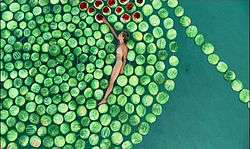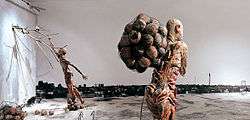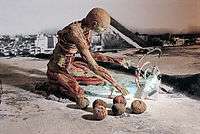Sigalit Landau
| Sigalit Landau | |
|---|---|
 | |
| Born |
1969 (age 46–47) Jerusalem, Israel |
| Nationality | Israeli |
| Known for | Sculptor, Video Artist |
| Movement | Israeli art |
Sigalit Landau (born 1969) is an Israeli sculptor, video and installation artist.
Biography
Sigalit Landau was born and raised in Jerusalem[1] and spent several years in the US and the UK. Her brother is the artist Daniel Landau[2] [3] [4] In 1993, she spent a year as an exchange student at Cooper Union School of Art and Design in New York. In 1994, she graduated from Bezalel Academy of Art and Design. Today she lives and works in Tel-Aviv.
Artistic career
In 1994, Landau took part in two group exhibitions as part of ArtFocus 1994. One of the exhibitions, Transit, was an art project that offered artists an exhibition space in the shopping area of the new Central Bus Station in Tel-Aviv. Landau chose to inhabit a hideaway space occupied by homeless people, which she found in the compound, where she created an installation that consisted of a series of doors scratched and punctured by metal fingernails.

In the late 1990s, Landau began to create video art works. One is Barbed Hula (2000), showing a nude female body (the artist’s) rolling on and around her belly a hula hoop made of barbed wire, which injures the skin with every move. The visual experience combines hypnotic beauty with a sense of excruciating pain, making it difficult to watch. In this work, as in some of her other videos, the theme of circular and cyclical motion is central. Landau integrates her experience in the medium of movement in space – she studied dance at the Jerusalem Academy of Music and Dance’s high school – with a deep understanding of the video-art form, which is based on continued movement and the projection cycle (loop).
In a review of her installation "Thread Waxing Space" in Frieze Magazine in October 2001, her work was described as "pleasure-filled and sugar-coated, consistently building upon narratives and myths, rewriting fables for post-modernity."[5]
In DeadSee (2005), the artist is filmed floating on the Dead Sea among hundreds of watermelons joined by a string that form a spiral. Some of the watermelons are open, with their wound-like red flesh accentuated by the green background. In a slow and hypnotizing motion, the string is pulled and the spiral is unraveled, allowing time for contemplation and reflection. The Dead Sea, both the place and the symbol, features in a number of Landau's works.
Landau describes her work as "bridge-building": “In my [sub]consciousness I search for new and vital materials for connecting the past with the future, the East with the West, and private with the collective … using scattered and broken words in order to define a pile of meaningless objects and transform it into a soft heap of dream buds, to influence the uncertain horizon."
In 2012, two bronze sculptures created by Landau were stolen from the yard of an art collector in Herzliya. Landau and the collector believe they were not stolen for their value as works of art, but by thieves who wanted to melt them down for the metal. The works were "Vomitus-Narcisus" (2007), depicting a pregnant woman staring into a pool of her own vomit, and "Stranded on a Watermelon in the Dead Sea" (2009), a figurative interpretation of Landau's 2005 video in which she was filmed trying to balance herself on a watermelon at the Dead Sea.[6]
Awards
- 1993 Jewish National Fund Sculpture Award
- 1994 America-Israel Cultural Fund
- 1994 Mary Fisher Prize, Bezalel Academy of Arts and Design, Jerusalem
- 1996 Ineborg Bachman Scholarship
- 1998 Artist in Residence at the Hoffmann Collection, Berlin
- 1999 First Prize in the British Competition by ArtAngel and London newspaper "The Times"
- 2001 Acquisition Prize, Tel Aviv Museum of Art, Tel Aviv
- 2001 Prize for a Young Artist, Israeli Ministry of Science, Culture and Sport
- 2003 America-Israel Cultural Foundation Janet and George Jaffin Scholarship Prize
- 2003 Residency, IASPIS - The International Artists Studio Program, Stockholm
- 2004 Nathan Gottesdiener Foundation, The Israeli Art Prize, Tel Aviv Museum of Art, Tel Aviv
- 2004 Beatrice S. Kolliner Award for Young Israeli Artist, Israel Museum, Jerusalem
- 2007 The Dan Sandel and the Sandel Family Foundation Sculpture Award, Tel Aviv Museum of Art
- 2012 'Artis' Grant Recipient
Exhibitions
- 1995 - Grrr… Har haBáyith, Israel Museum, Jerusalem (With Gay Bar Amoz)
- 1997 - documenta 10, Kassel
- 1997 - Israeli Pavilion, Venice Biennale (With Miriam Cabessa and Yossi Breger)
- 2002 - The Country, Alon Segev Gallery, Tel Aviv
- 2005 - The Endless Solution, Helena Rubinstein Pavilion for Contemporary Art
- 2008 — Salt sails+Suger knots, kamel mennour, Paris
- 2008 - "Imaginary Coordinates," Spertus Museum, Chicago, IL
- 2008 — Projects 87, The Museum of Modern Art, New York
- 2007 — The Dining Hall, Kunst-Werke Institute for Contemporary Art, Berlin
- 2011 — One Man's Floor is Another Man's Feeling, Israeli Pavilion, Venice Biennale
- 2012— Angel Landry, Givon Gallery, Tel Aviv
- 2012 — Soil. Nur.sing, kamel mennour, Paris.
- 2012 - Caryatid. The Negev Museum of Art, Beersheva, Israel
- 2013 - ‘The Ram in the Thicket’ Maison Hermes in Ginza, Tokyo. Curator: Reiko Setsuda
- 2013 - ‘ZBIB EL-ARD’ Har-El Printers & Publishers, Jaffa. Curator: Matti Harel
Gallery
 Thread Waxing Space installation, 2001
Thread Waxing Space installation, 2001
Thread Waxing Space, New York The Country (Installation view), 2002
The Country (Installation view), 2002
Alon Segev Gallery, Tel Aviv-Yaffo The Recorder of Days and Fruit, 2002
The Recorder of Days and Fruit, 2002
from "The Country", Alon Segev Gallery, Tel Aviv-Yaffo
 Cry Boy, Cry, 2004
Cry Boy, Cry, 2004
Tel Aviv Museum of Art Sisyphus and Jacob, 2005
Sisyphus and Jacob, 2005
Tel Aviv Museum of Art The Dining Hall (Installation view), 2007
The Dining Hall (Installation view), 2007
KW Institute for Contemporary Art, Berlin.jpg) Salted Lake (Salt Crystal Shoes on a Frozen Lake), 2011
Salted Lake (Salt Crystal Shoes on a Frozen Lake), 2011
Video projection (HD)
11:04 mins.
Israel Museum, Jerusalem
See also
References
- ↑ Biography
- ↑ Yuval Avivi, An interview with Daniel Landau, Time out Tel Aviv, September 2, 2013
- ↑ Matan Shiram, "practical art" coferene: discussion about the interaction between arts and marketing nowdays", Globes, June 19, 2014
- ↑ Yonatan Esterkin, "Four walls jungle", an interview with Daniel Landau, Nrg Maariv, September 26, 2009
- ↑ Frieze Magazine, review: Sigalit Landau
- ↑ Pricey works of art snatched from Israeli collector's yard, Haaretz
External links
- http://www.sigalitlandau.com/
- *Podcast/interview with Sigalit Landau, 2015
- Sigalit Landau collection at the Israel Museum. Retrieved January 22, 2012
- "Sigalit Landau". Information Center for Israeli Art. Israel Museum. Retrieved January 22, 2012.
- Art of Sigalit Landau at Europeana. Retrieved January 22, 2012